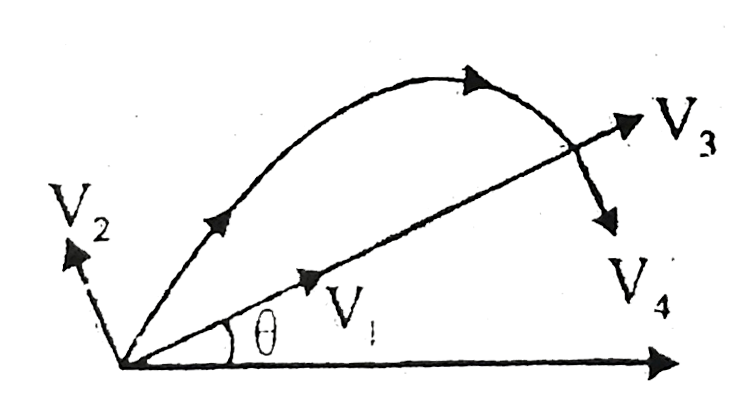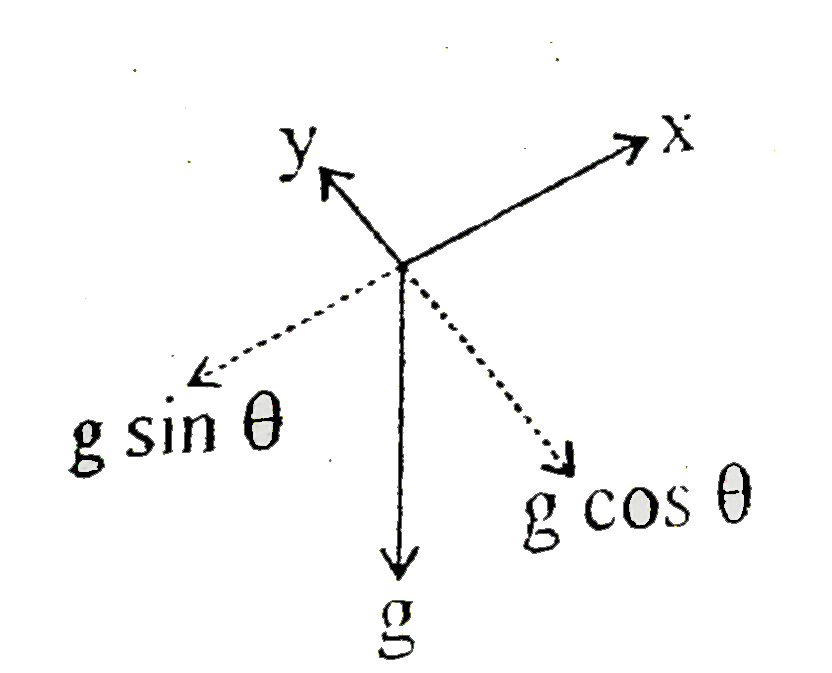A projectile is projected on the inclined plane as shown V1&V2 are components of it's initial velocity along the incline and perpendicular to incline and V3&V4 are components of it's final velocity along the incline and perpendicular to incline. {Here we are comparing the magnitudes only}

V1>V3
V1=V3
V2=V4
V2>V4
The correct Answer is:A, C

V23=V21−2gsinθxsoV3<V1
V24=V222gcosθ(Δy)=V22−2gcosθ(0)=V22
V4=V2
Topper's Solved these Questions
- BOOK - BANSALCHAPTER - MASTER PRACTICE PROBLEMEXERCISE - Subjective107videos
MASTER PRACTICE PROBLEM
- BOOK - BANSALCHAPTER - MASTER PRACTICE PROBLEMEXERCISE - Additional topic70videos
MASTER PRACTICE PROBLEM
- BOOK - BANSALCHAPTER - MASTER PRACTICE PROBLEMEXERCISE - Reasoning75videos
MASTER PRACTICE PROBLEM
- BOOK - BANSALCHAPTER - FLUID MECHANICSEXERCISE - PYQS AIEEE10videos
FLUID MECHANICS
- BOOK - BANSALCHAPTER - SEMICONDUCTORSEXERCISE - CBSE Question32videos
SEMICONDUCTORS
Similar Questions
In a given system of unit standard measurement of mass is 100 gm standard measurement of length is 200 cm and standard measurement of time is 5 sec 10 J energy in the given system of unit has value N, then value of N is
02:55View SolutionThe manifestation of band structure in solids is due to
04:49View SolutionStatement-1: The numerical value (n)of a physical quantity is inversely proportional to size of unit (u) being used to measure it.
Statement-2:The magnitude of physical quantity does not change by changing the units.07:07View SolutionA cylinder of height 20m is completely filled with water. The velocity of effux of water (∈ms−1) through a small hole on the side wall of the cylinder near its bottom is
02:38View SolutionHow does the width of the depletion layer of a p-n junction diode change with decrease in reverse bias?
05:24View SolutionComponents Of Acceleration Along And Perpendicular To Inclined Plane
05:50View SolutionA projectile is fired with a velocity v at right angle to the slope inclined at an angle theta with the horizontal. The range of the projectile along the inclined plane is
05:00View SolutionA particle is projected up the inclined such that its component of velocity along the incline is 10m/s. Time of flight is 2 sec and maximum height above the incline is 5m. Then velocity of projection will be
05:03View SolutionA solid iron sphere A rolls down an inclined plane, while another hollow sphere B with the same mass and same radius also rolls down the inclided plane. If V_(A) and V_(B) are their velocities a the bottom of the inclined plane. Then
03:25View SolutionIn the given figure , the angle of inclination of the inclined plane is 30^(@) . A particle is projected with horizontal velocity v_(0) from height H. Find the horizotnal velocity v_(0) (in m/s) so that the particle hits the inclined plane perpendicu lar .Given H=4m, g =10m//s^(2) .
02:25View SolutionA particle is projected up the incline such that its component of velocity along the incline is 10 ms^(-1) . Time of flight is 4 sec and maximum height above the incline is 5m . Then velocity of projection will be :
View Solution[" A projectile is fired with a velocity "v_(0)" at an "],[" angle of "90^(@)" with an inclined plane (having "],[" angle of inclination "theta" with the horizontal)."],[" Vertical displacement of projectile when it "],[" strikes the incline for first time is "],[qquad [v_(0)],[y]]
06:04View Solution[" A projectile is fired with a velocity "v_(0)" at an angle "],[" of "90^(@)" with an inclined plane (having angle of "],[" inclination "theta" with the horizontal).Vertical "],[" displacement of projectile when it strikes the "],[" incline for first time is "]
View Solution[" A projectile is fired with a velocity "v_(0)" at an angle of "90^(@)" with "],[" an inclined plane (having angle of inclination "theta" with the "],[" horizontal).Vertical displacement of projectile when it "],[" strikes the incline for first time is "]
07:54View SolutionAn electron of mass m and charge e initially at rest gets accelerated by a constant electric field E. The rate of change of de-Broglie wavelength of this electron at time t ignoring relativistic effects is
View Solution

